
Lockdown madness goes on, even as science shows COVID isn’t that deadly


Turning and turning in a widening gyre
A conventional narrative among political commentators of our day has been one of increasing polarisation and a collapsing ‘middle’. In economics, leading international think-tanks like the OECD are writing reports with catchy titles like “Under Pressure: The Squeezed Middle Class“. In the media, pundits are falling over each other to predict the demise of the political centre.
And while the centre may indeed be under threat, there is little-to-no evidence of increased political polarisation. Across Europe, an unprecedented number of ‘grand coalitions’ have arisen in recent years, bringing traditionally opposed centre-right and centre-left parties into government together. While very recently there has been some weakening, the bigger picture is how remarkably stable this arrangement has proven. Meanwhile across the Pond, despite what social media outrage would have you believe, the extent of bipartisanship has been on a steady rise for almost a decade – spanning both Obama II and the Trump Administration. This should come as no surprise to anyone paying attention to how the American political system really works. The donor class tends to stick its fingers into both the Republican and the Democrat pies, in more or less equal measure. Party bickering is a useful tool to deflect public attention away from the real issues, but when it starts to impede on the business of the State, the interests are quick to take notice.
The worst lack all conviction
Yet there is a divide opening up, of another kind. I see it as the increasing disparity between the interests of the political class and those of the people they are supposed to serve . In this sense the ‘middle’ is, and has always been, a careful compromise between the public interest and the interests of those who represent the public. The fact that vested interests and lobbyists choose to buy favour among the political class is nothing new. It is how business gets done. What has changed is the extent to which those vested interests deviate from the public interest. As globalisation and increasing human population ratchet up the scale and reach of public policymaking, the stakes go up. The decisions of our day – on how to regulate corporations that are bigger than countries, on how to handle the migration of millions, on how to deal with climate change – are bigger than anything we have faced before. This means public policy matters more, and the size of the ‘middle’, the gap between the people and its representatives, is growing.
In America, the Democrats have traditionally positioned themselves closer to this space, but at least since the Obama Administration it has become piercingly clear to anyone watching that establishment Democrats have moved far, far away from the interests of ordinary people. The two-party system prevents them from experiencing an out-in-out decline, simply because there are no voting alternatives. Yet the fracturing witnessed among the base during the 2016 Presidential campaign had the same political effect. Since 2004, the percentage of Americans identifying as politically independent has been on a steady rise, and now outnumbers either Democrats or Republicans.
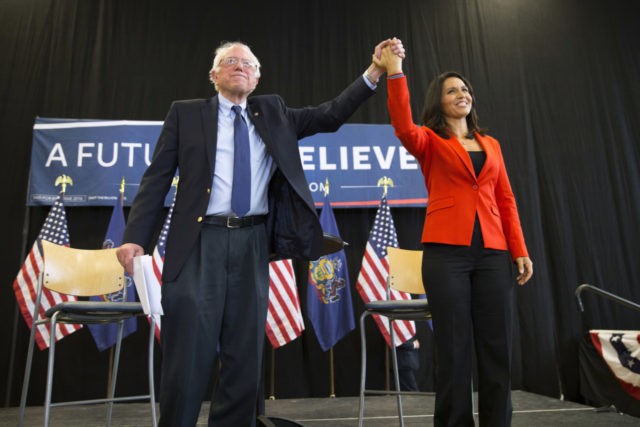
In Europe, the near universal decline of ‘centre’-left social democrat parties – once the parties of the masses – tells a similar tale of elites leaving their bases behind. The ‘centre’-right too has drifted away from its base; in Germany most notably through the policies of open immigration which the CDU Chancellor Merkel pursued in the teeth of public opposition.
Other issues foster latent resentment, such as the ever-expanding grasp of monopolies under the guise of intellectual property rights. Voters might not know exactly how political elites have allowed corporatists to privatise public ideas, but they can sense it. It feeds into a wider sense of social malaise.
But where the Establishment has abandoned the middle most evidently is in American military foreign policy. The consensus among ordinary Americans against funding rogue regimes like Saudi Arabia and getting stuck in endless, pointless regime-change wars like Afghanistan and Syria is as overwhelming as it is obvious. What is not as obvious is how political representatives fail to take any action: A bipartisan bill sponsored by Rand Paul to curb Presidential power in this respect and withdraw from Afghanistan has languished in the Senate since April. Why? Surely it is because the political elites are captured by a vested interest, this time the military industrial complex.
While the best are full of passionate intensity
In the face of this drift, the ‘collapse of the middle’ is the death of the convenant these traditional Establishment parties had with the public they only ever uneasily served. But others are moving quickly to fill the space, and the Establishment is quick to brand them with the now-tired dysphemism ‘populist’. Trump is commonly thought of as being in the vanguard of this new kind of populist. But in truth, he is only the loudest and most showmanlike of its outriders. In Eastern Europe, where the Establishment was less … established, populist leaders responded to the drift more quickly.
And on the political left, the wrangling over the 2020 Democratic party nomination shows this new divide quite clearly. On one side, the Establishment candidates, led by Joe Biden, Pete Buttigieg, Cory Booker, and … it would seem, Elizabeth Warren. They are backed by big donors but get only a lukewarm reception from the public. Against them the three anti-establishment candidates – the ‘populists’ if you will – of Bernie Sanders (with his vastly popular Medicare for All plan), Tulsi Gabbard (with her vastly popular End Regime-Change War platform) and Andrew Yang (with his vastly popular Universal Basic Income plan). They fight an almost endless battle against media smears and unfavourable coverage, relying on the internet for publicity and on small political donations from actual grassroots supporters for cold, hard cash. Since in this light, it’s wholly unsurprising that they are the candidates Trump voters are most likely to support if they decide to switch. After all, they are fellow ‘centrists’.
One does not have to look very long at history to guess which side will eventually come out on top. The Establishment, as it veers towards the extremes, will crack and fade and a new political middle will reform. It’s already happening. The pundits on television just don’t know it yet.
Divided we tweet
It seems that the public debate is divisive as never before. Left versus right. Social Justice Warriors (whatever they are) versus the alt-right (whatever that is). Admittedly, this impression may simply be a result of our unhealthy addiction to social media, which through its Algorithms of Hate and its cloak of anonymity tends to radicalise latent tendencies. It drives us into tunnels with those who share our vision, while at the same time shielding us from the consequences of our push-button outrage.
Nonetheless, I would contend that the fabric of culture is indeed in the process of tearing. The seams of our civilisation – things like basic human dignity, kindness, respect, humanity and tradition – now seem incapable of holding us together against the pressure of our outrage. The space for reasoned debate seems to shrink with every passing tweet.
A change is as good as the rest
The trouble is that the two sides are not even consistent in their own viewpoints. In the United States, the Democrats – formally defenders of the economically disadvantaged – have somehow come to represent an uneasy alliance between middle- and upperclass privileged ‘Coastals’ and traditional urban ethnic minorities, while the Republicans draw support from the equally awkward bedfellows of the superrich and the underclass of rusting, undereducated, mostly white ‘Heartlanders’. Neither side consistently upholds the values of the left (i.e. a larger state, more redistribution, protection of workers rights) or the right (more free market, less regulation, lower taxes and a smaller state). Members of a group which formally advocated liberal values such as free speech now rally behind brutal authoritarian slogans like “punch a Nazi”, failing to appreciate the irony of their own intolerance.
In Europe, mainstream social democrats increasingly resemble historical anachronisms, while the (Christian democrat) centre-right, desperate to hold on to a collapsing middle, is being overtaken by populists. The CDU in Germany has through the open borders refugee politics of Angela Merkel betrayed many of its own base, while the centre-left’s failure to check the consequences of rising inequality and globalisation constitutes an equal betrayal in the eyes of the old working class faithful. In Britain, the single-issue of Brexit has torn apart both the Conservatives and Labour. In its place, it has forged an unlikely anti-EU alliance between post-industrial working class northerners and well-off village conservationists in the affluent Home Counties which surround the (anti-Brexit) London metropolis. Only yesterday, Italy joined in the fun by voting in populists and extremists and booting out the moderate centre-left. But nothing illustrates the collapse of the old left-right dichotomy as forcefully as the 2017 French presidential election, which saw Emmanuel Macron’s virgin movement sweep aside both the PS and the Gaullists in his ascent to the Elysée throne, although the real victor was Madame l’Absention, followed closely by Madame Le Pen.
New times call for new political structures
The problem is, the model of the old left-right divide has always been missing something important. It was only ever the particular circumstances created by industrialisation which allowed for this one-dimensional approach to work as a good approximation. The left-right split also had the added advantage of convenience, in that the institutions of representative democracy work best when competition for political power is limited to a few, slightly differentiated brands. Being able to position two, three or four parties on a single spectrum reduced the task of political choice to something the masses could participate in without much active engagement or intelligence. The accidental balance created by industrialisation permitted us to overlook the fact that the model we were using to think about society was fundamentally flawed. As the world evolves, that balance is increasingly disturbed. We need to develop a new framework. As the world becomes more complex, so too much our political framework.
But how to adapt the model? Ideas abound; a popular version adds another ‘ecology’ dimension to the old left-right divide. However, in practice, environmentalism is less a coherent ideology and more a loosely grouped set of specific policy challenges. Once you break it down, the solutions to environmental problems can be tackled by taking a position on the conventional left-right spectrum. For instance, if you’re a left-winger, pollution taxes which internalise the externality seem like a good idea; if you’re a right-winger, you might like tradable pollution permits which achieve the same result. Nor does the environment feature particularly strongly in the ideological divide that is tearing the Western world apart at present.
The Social Triangle
I propose instead a 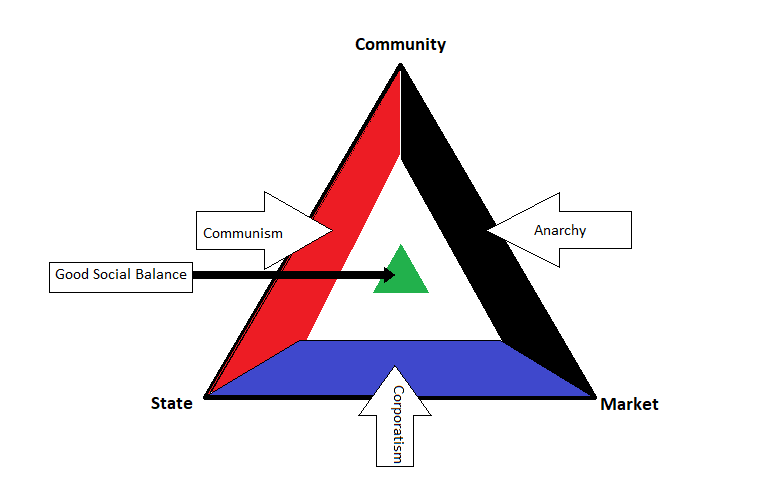 model which takes into account the dimension I feel has been missing. As the diagramme illustrates, we can see society as consisting of three dimensions, the two which are conventionally understood in existing political analysis (the State and the market) and a third, that of community. Community can be understood as the voluntary organisation of people in groups without a specific transactional motivation (which is the market) and without the element of compulsion/threat of violence (which is the state). I argue that the absence of this dimension has, up to now, remained unobserved because we have in essence taken the role of community for granted. It is only as communities collapse – i.e. as society begins to drift ‘downwards’ towards the bottom side of the triangle – that we notice its absence. It is marked by a tendency towards the unholy alliance between the state and the market, in the form of corporatism.
model which takes into account the dimension I feel has been missing. As the diagramme illustrates, we can see society as consisting of three dimensions, the two which are conventionally understood in existing political analysis (the State and the market) and a third, that of community. Community can be understood as the voluntary organisation of people in groups without a specific transactional motivation (which is the market) and without the element of compulsion/threat of violence (which is the state). I argue that the absence of this dimension has, up to now, remained unobserved because we have in essence taken the role of community for granted. It is only as communities collapse – i.e. as society begins to drift ‘downwards’ towards the bottom side of the triangle – that we notice its absence. It is marked by a tendency towards the unholy alliance between the state and the market, in the form of corporatism.
Bowling alone
When looked at this way, society can be properly understood to be positioned somewhere within the above triangle. Societies that are more communistic can be placed within the red area of the triangle; those that are more anarchistic within the black area; and those that are more corporatist within the blue area. An ideally functioning society, like a three-legged table, balances all three dimensions and ends up somewhere in the green centre. Of course, in today’s world, we are observing a collapse of community – a massive drop-off in religious subscriptions, fewer bowling clubs, the death of the Boy Scouts, etc. and so we have drifted downwards, further towards corporatism. In such a world, the negative effects of the free market become more apparent as, for instance, the lack of community leads to an erosion of business ethics. But equally, a lack of community (for instance in the form of charities) heightens reliance on state-provided forms of welfare, revealing the innate corruption and incompetence of the state’s bureaucracy. Supporters of Donald Trump scream at supporters of Hillary Clinton and vice versa, but in the end, they are both suffering from the same affliction; a lack of community. The rise of populism is not a cry for more or less free market, nor is it a cry for a bigger or smaller role of the state. It is a cry for more community.
Which leads to the next question: What is leading to the erosion of community and how can we reverse this? That is perhaps the subject of another blogpost.
United we chat; divided we shout at each other
I promised myself I would not write a post about the Charlottesville riots, the near universal condemnation of Donald Trump’s nuanced position and the taking down of Confederate-era statues. Yet a recent conversation has forced my figurative hand onto the keyboard. I’ll keep my promise nonetheless, by writing instead a post about free speech, and avoiding the specific reference to the recent events in Virginia.
In the conversation, I was accused of being a “white supremacist apologist”, a charge which I found hurtful not for its substance – which missed wide of the mark – but because I care deeply about the person who made it. It revealed to me on a personal level just how fraught are the fault lines that are emerging in this increasingly divided world, and the dangers they present for what I believe to be the finest part of Western culture – intellectual liberty.

Tell me what I want to hear, or STFU
They say in war, truth is the first casualty. I think the first casualty is probably free speech. Wartime demands adherence to dogma. And for dogma to take hold, there must first be a climate in which dissent is not peacefully tolerated. Once dogma has control, it can structure the narrative in whatever way suits the agenda of those in power.
Against this it is often argued that free speech needs its limits. Indeed, the debate has been had in many forms and in many places. It’s not hard to put up a straw man which would appear to demonstrate that, after all, free speech must have its bounds: Shouting ‘fire’ in a crowded theatre; slander; incitement to violence.
Yet in the current climate, it is the principle of free speech that is at stake, not the precise definition of its ultimate boundaries. Guaranteeing the right to free speech, by definition, means accepting a person’s right to say things – not only with which you disagree – but which you find utterly morally repugnant. Just as you cannot make peace with anyone except your enemies, you cannot acknowledge the right to dissent from anyone except those with whom you disagree.
Free speech – just grist in the Mill?
The principle of free speech comes to us from the Enlightenment, refined and perfected by the great liberal philosophers John Stuart Mill and Wilhelm von Humboldt. In a nutshell, it’s predicated on a belief that truth is something we arrive at through reason, and that reason is a faculty which humans innately possess. It follows from this basic principle that allowing the vile and deceitful to speak freely is not, after all, dangerous. This is because no argument of theirs, if weak and untrue, presents much of a danger, provided its opponents are also at liberty to proffer the (strong and true) counterargument. Like the edit wars of a popular Wiki page, those who spot Elvis pumping gas on the outskirts of Reno will eventually be overruled through an iterative process of argumentation. The truth will ultimately prevail, or at least that which prevails has the best chance of being true.
Those who would resist free speech in the name of an ideology tacitly acknowledge the weakness of their own dogma. They fear dissent either because they do not believe in the fundamental truth of their dogma, because they do not trust in the innate capacity for reason of their fellow man, or else (and this is perhaps the worst alternative) they do not believe at all in the concept of objective truth; leaving only the moral logic of ‘might makes right’.
The Age of Befuddlement is upon us
It saddens me that I should have to write a post like this. I would prefer to think that in the Western World – a place where mass education and universal literacy have existed for many decades – the principles of liberty and free speech would be universally accepted. To witness the barbaric hoards of left-wing dogmatists (I shall not call them ‘liberals’ for fear of making Mill turn in his grave) doxing, rioting and intimidating their opponents is not only saddening because of how self-defeating it is in terms of fighting racism, but also because it reveals their contempt for the greatest principle we have: Freedom of expression.
A gap by Any Other Name…
The official website for statistics of the European Union is called Eurostat. If you visit their website, and I highly suggest you do, you will find among the many interesting databases one for the Gender Pay Gap, which measures the difference in average gross hourly earnings between men and women for all European countries (and a few other places too). The message you’re supposed to get from this is that men get paid more than women for doing the same work.
This measure is more than just a statistic, it is a political construct. Despite the fact that it doesn’t really mean what people think it means, the GPG is much quoted in the media, by feminists and even by mainstream politicians. It helps that it has become a sort of catch-phrase, earning its very own capital letters. Because we all know that when a concept becomes capitalised, it Must Be True. And so misread, the Gap sparks outrage, even to the point of politicians passing rather draconian rules to try and level the playing field.
Don’t let reality get in the way of a good story
However, when you start to take a closer look at the Gender Pay Gap in its crude and unadjusted form, for instance by taking into account differences in risk-taking, career choices and hours worked, the difference in pay falls dramatically. And then there’s the fact that the measure tells us nothing about household income distribution. True, men often opt for longer hours (at higher pay) than women because they have wives back home to take care of the kids, but these same men are bound by custom and by the law to share their extra earnings with their families. The value of interhousehold transfers far exceeds the earnings gap, and you can see this by looking at this handy spousal maintenance calculator, which tells us that when it comes to the divorce, a man in the UK earning £40,000 a year will be due to pay his wife, if she earns £30,000 a year, £5,000/year in maintenance. That difference wipes away the benefits he might be getting from the Gap in one fell swoop.
Another way of seeing this is by looking at differences in net disposable household income by gender (which pools household income, and takes into account the value of taxes, and transfers received from the government – in this way we can compare, say, a single female householder to her married male colleague who has two kids to support). This gap is much smaller than the GPG would suggest, and among younger households it is almost zero.
But don’t take my word for the fact that the Gap is meaningless. Consider the view of one group who rarely consider any ideology beyond the Almighty Dollar: Capitalists. Here we see that market researchers are not fooled by the policy bias. They know that women make up 85% of all consumers. Sure, a lot of this is spent on stuff for the family, but even for the pure luxury good market – leisure activities, fancy clothes, dining out, perfumes and chocolate – the gender bias is evident: Men earn the money, but women spend it.
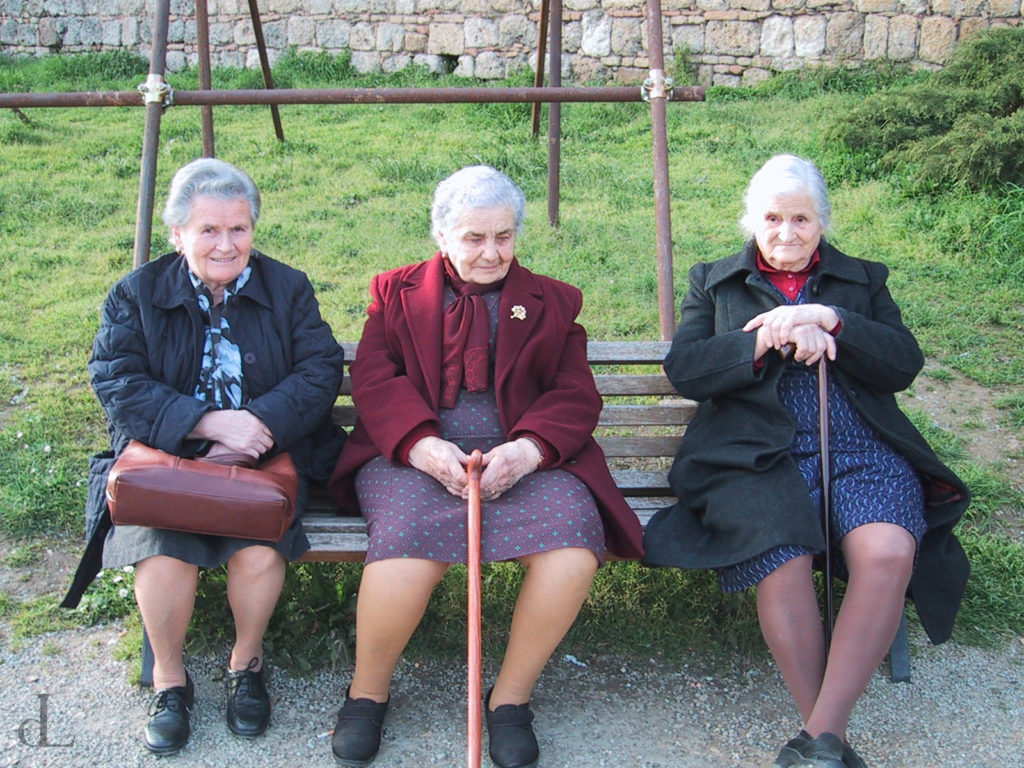
Mind the Gap
Yet that somehow doesn’t slow the narrative, nor dampen the outrage. The feminist policy lobby argues that even when you control for hours worked, career choices and risks taken, a Gender Pay Gap remains (admittedly then much smaller) . And this, they exclaim, is pure discrimination, and must be stomped out by all means necessary.
If you were to suggest the remaining gap can be explained by men – high on testosterone – being simply better at competing in high-value, high-stress work environments, you would be branded a male chauvinist pig. Fearful of this kind of branding, I’ll not dare to suggest such a thing myself.
Check your privilege, and then man the hell up!
Yet weirdly, testosterone is exactly the explanation which is tossed about whenever it comes time to discuss a far more pressing, far clearer gender discrepancy – the gap in mortality between women and men. Here, it is the very risk-taking which leads to higher rates of occupational accidents, which in turn kill off men at a faster rate than women. In other words, if a man takes risks and dies for it, he has only his toxic masculinity to blame. If he takes risks and gets paid more for it: INJUSTICE!
The Gender Mortality Gap is, as far as I can tell, a phrase coined by me. Normally I’m proud of being able to claim credit for stuff, but in this case I find it alarming that the most obvious, most enduring gender injustice on the planet needs a third-rate occasional blogger like me to invent its catch-phrase. No entry in Eurostat. No Barack Obama waxing lyrical about giving our men back their lives, from behind the Presidential pulpit. Just a guy with a receding hairline and a WordPress site.
Only the men die young
Yet the GMG is real. Though Eurostat doesn’t have a special table for it like for the Gender Pay Gap, but you can still go to their website and calculate the difference in average life expectancy for women and men: For the EU as a whole, the GMG for newborns is 5.4 years, though it varies from 3.3 in the Netherlands to 4.8 in Germany; 6.3 in France; and as high as 10.5 in Lithuania (the US is close to this higher number too). And unlike the figures for hourly pay, which don’t take into account self-employment or black market earnings, statistics on death are among the most reliable we have. There is no trickery here: If you’ve had the misfortune to be born with a penis, you’re probably going to die 5 years younger than your twin sister.
So while the policy world is busy imagining ways to force the free market to pay women more, nobody is asking about what policies are needed to help men live longer. Fortunately there is a clear answer: Spend more money on public health, preventative and curative healthcare for men. The imperative to do so is all the more striking when we consider the fact that men, as the majority taxpayers in countries that publicly fund universal health systems, don’t even get an equal share of the treatments they are shelling out for. The statistics are scant, but the OECD reckons that €1.12 is spent on women’s healthcare for every Euro spent on men’s (this excludes the cost of reproductive treatments such as maternity, pre- and post-natal care).
The People think they want change
Ok, there is a lot of anger out there. Some are angry because they fear the ‘other’ taking away what they have; others are angry because they want more redistribution and fairness. Some blame benefit-scrounging immigrants, others blame the global elites. But while the grumbles might be diverse, there is a common sense that the system is somehow ‘broken’ in a way it wasn’t before. Whether it means Trump, Brexit or someone like Bernie Sanders, a large number of people who previously would have been moderates now want – or at very least expect – to see fundamental change to the societies and political systems they consider have failed. Alarmingly, they seem prepared to topple long-established systems and political traditions in order to see this change happen.
And maybe they’re right. Who knows? The consequences of disruptive change are hard to predict in the short run, and ultimately may take a very long time to play out fully. When Nixon visited Beijing in 1972, he asked the witty and influential Chinese mandarin Zhou Enlai his opinion on what impact the 1789 French Revolution had had on history, to which Enlai is said to have replied that it was “too early to say”.
Nature red in tooth and claw
But it seems to me the risks are very much on the downside. To paraphrase John Lennon, if disruptive change means destruction, you can count me out . Our system may not be perfect, but it is a hell of a lot better than nothing. To see how, consider what things would be like in the complete absence of society. Imagine an invisible hand picked any one of us up from his current desk, couch, bed, airplane seat … and carried him out of his man-made environment and place him, naked, in a

theoretical primeval forest where other humans simply did not exist. This is the total absence of society. How well would he fare? He might last a week before getting eaten. A summer, perhaps, if he is particularly crafty and in good health. But come winter, he would freeze, starve or get eaten by wolves. The first major injury or illness would likely finish him off. And even if, by some miracle, he managed to carve out a niche (most likely literally) for himself, would his quality of life be even a fraction of what it is now? I remember an excellent article written by Alan Weisman in Discover Magazine back in 2005 which explored the world without humans. It was a romantic vision, full of evocative prose of species flourishing and cities crumbling. The descriptions made it clear a little bit of the author’s heart longed for such a thing to take place. Yet where is Mr Weisman now? Living in one of the few remaining wildernesses in Alaska or Russia which closely approximate his vision? I’m guessing not. Especially as he was sending pre-apocalyptic tweets as recently as 2014.
Creature comforts are better than creatures
This thought exercise is designed to remind us of just what a good job society does at shielding us from what is, in reality, a hostile physical environment. Such a good job, in fact, that we forget we are being shielded. Unlike the current political system, Nature isn’t just guilty of neglecting our interests and selling us a bit of Fake News. Nature actively wants us to die. It wants to dispatch predators to eat us, it wants to release diseases to sicken us, or else simply deny us food and watch us starve. The system, far from being broken, does an absolutely remarkable job of taming Nature and providing us with far more than what we could have on our own. What’s more, it is better at doing this now, than at any point in human history.
If we allow this system to be torn down, perhaps a better one will rise from the ashes and we will achieve some kind of Utopia. But that seems like a bad bet, given what we know from history and observing the physical world around us. Disruptive change is more likely to give Nature the opening she has been seeking for centuries. She might rub her hands in glee while we starve in our billions. Animals or bacteria could so easily overwhelm us, and in the ensuring mayhem we would likely turn on each other. Then, somewhere in the mud and mess, those among the living who were old enough to remember would regret that they so cheaply threw away a system they thought was broken, but in reality was only a little bit flawed.
If you know me or have visited this blog before, you’ll know that my book, The Hydra, is about overpopulation. In it, a scientist decides the world is so full of humans, that he must save the planet by engineering and releasing an infertility virus. I won’t give away too much of the plot, but suffice it to say as a novel it doesn’t really do much hard number crunching. It begs -but perhaps never really comprehensively answers- the crucial question: Is the world so overpopulated that we’ll destroy the planet unless we change our policy direction?
Indeed, when you discuss the issue with most people, you get lots of uninformed opinions, which range from “I think we’re all doomed, unless there’s some major war or something” to “There are definitely not too many people in the world. It’s just a question of sharing out the world’s resources fairly and investing in technology instead of war” I always find it astounding just how convinced both sides can be of their opinions, without the faintest notion of what the hard numbers are saying.
So let’s see if we can do any better. First stop, the databank of the World Bank where, after some data cleaning, we can come up with a list of useful data for the world’s countries, grouped into categories depending on how rich they are. Basically we’re looking at four things: population, Greenhouse Gas (GHG) emissions, GDP and birth/death rates, from 1960 to 2015.
What can we see from the numbers?
The first thing to look at is Greenhouse Gas (GHG) emissions. By 2012 we humans had pumped about 567 gigatonnes of CO2 equivalent (GtCO2) into the atmosphere since the dawn of industrialisation (1870). In 2012 alone we added 52 GtCO2 to this stock, up from an annual total of 27 in 1970. While the data are jumpy, on average, the amount of carbon we release in the atmosphere annually is growing by about 1.3% a year. Even if this pace of annual emissions growth were to fall from 1.3% to 0% a year, that would still mean we would be adding the 2012 payload of 52 GtCO2 into the atmosphere every year. If that level of emissions were to continue until 2050, that would result in an atmosphere laden with 2,572 GtCO2 released by humans. That number is so big, it is literally off the charts, as far as the climate scientists are concerned. To illustrate, I’ve made a simplified version of “the chart”, i.e. the UN’s reckoning of how cumulative emissions will raise temperatures. You can find the full chart on page 54 of this document.
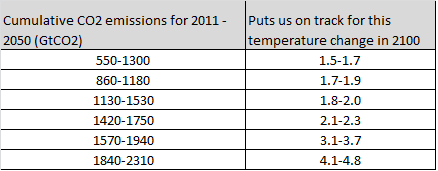
As you can see, they don’t even consider a scenario in which we keep emitting the level of GHG which we emitted in 2012. What this is telling us is pretty clear: if we continue with business as usual, we’re going to miss the current climate targets by more than a factor of 2, resulting in massive, truly massive, changes to our climate which may well spell disaster for the planet and for us all. Now of course, nobody believes business as usual is an option, which is why we had Kyoto and then Paris and soon Marrakesh.
Linking emissions to income
Money makes the world go round. And it also determines how much GHG we put into the atmosphere. Or more precisely, the things people like to spend money on: heat, bigger houses, clothes, high-protein food, transport. The precise link between income and emissions depends on where a person is on the income scale: For very rich countries, there is already evidence of ‘decoupling’, i.e. as rich people get richer, emissions don’t increase, they actually go down. But because rich countries only account for 15% of the world’s population, that doesn’t really matter. What matters are the middle income countries, places like China and Brazil, who make up 35% of the world’s population. The 2.6 billion people living in these countries have been getting richer since 1990, and whenever they’ve got their extra cash, they’ve burned it and pumped it into the atmosphere. Here’s the chart that shows it:
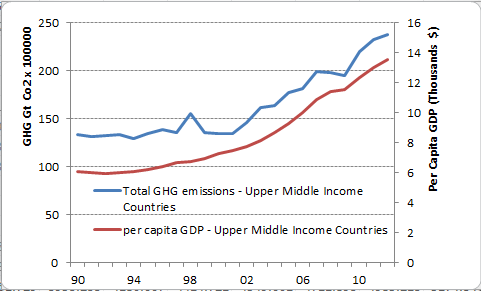
As these countries get to the sort of income levels the rich world has already achieved (and they are well on their way) there is every reason to assume that they too will ‘decouple’ emissions from growth, but for now, they are still hungering for more of the things that make the atmosphere hot: steak, cars, swimming pools and city breaks. And this is set to go on into the foreseeable future.
The real problem, though, is the next wave of countries, the so-called “Lower Middle Income” countries like India, which as a group are home to even more homo sapiens (2.8 billion or 40% of the world’s population). If these countries grow in the same way as China and Brazil have done, it will mean even more pressure to emit.
The power of econometrics can help us to estimate this relationship, which turns out to be very well approximated by the equation [kilograms of emissions / per person] = 1090 + (0.7093)*[GDP/person] – (0.0000047025)*[GDP/person]^2 – (0.00000000010531380)*[GDP/person]^3. If you want the nerdy details of where I got this, click here, but for everyone else I’ll just summarise what this means: If you have zero income, you will still emit about 1,000 kg of CO2 equivalent into the atmosphere every year. Emissions go up at about a rate of 700 grams a year for every dollar of extra income you get, but this slows down as your income approaches $35,000 a year. After that, extra income leads to lower carbon emissions per year. Here’s what the graph looks like:
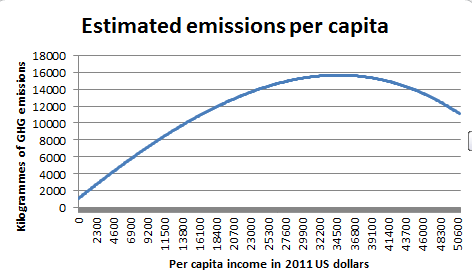
So what about population?
In 2015, there were 7.3 billion humans on Earth, more than ever before. This population increases about 1.2% a year, and while the rate of increase has been slowing since the late 1960s, it hasn’t been slowing by very much. If the pace of population increase we have observed since 1969 were to continue (i.e. let’s assume it continues slowing a bit every year, like it has been doing) there would be 9.75 billion of us by 2050. This, by the way, is the EXACT baseline estimate for the UN’s own population projects, but more about the UN’s numbers in a bit.
The main driver in the growth of populations is the crude birth rate, which measures how many children are born per 1,000 people. It turns out there’s a pretty stable relationship between birth rates and per capita GDP. Crude birth rates have been going down pretty much everywhere in the world, and it’s because of money. Basically, the richer a country, the fewer babies they make. In very poor countries, crude birth rates are around 35-40; as a country gets richer, the birth rate falls to just under 10. Figure X illustrates the relationship, which mathematically can be approximated by this formula: b = (45 * minY^a)/Y^a, where b = birth rate, Y is per capita GDP, and a is a “shape parameter” which is somewhere in the range of 0.2622 to 0.36487 Again, for the nerds out there, all the details are here.
The other thing that affects population is the death rate (deaths per 1,000 population). This too is ultimately a function of cash, but the relationship’s a little trickier because of demographic effects. (For example, Germany’s death rate is higher than Zimbabwe’s, not because Mugabe has better health policies than Merkel, but because, when you break it down, old age is the single worst thing for your health, no matter how rich you are. And Germany simply has a lot more old people than Zimbabwe.)
But here again, statistics can come to our aid. We can isolate the effect of the demographics and when we do, we get a pretty similar relationship as with per capita income. This is the equation that tells the story: d = (minY^a)/Y^a * (1/AGE^g), where d = the death rate, minY is a constant equal to 1,011, Y is per capita GDP, AGE is the percentage of the population aged over 65 and a and g are shape parameters equal to 1.0144 and -2.0097 respectively. In other words, the richer a country’s people are, the lower its death rate. The more oldies are in a country’s population, the higher the death rate.
So to recap, as people get richer, they have fewer babies, but they also tend to live longer, and we can use statistics to estimate by how much this is so for every extra dollar of income they get.
Putting it all together
Equipped with the three sets of estimations we have done above, we are ready to put the whole picture together. The first step is to make an assumption about how per capita GDP might evolve in the future. Of course we don’t know, but let’s imagine it continues to grow at the same annual rate it has been growing from 1990 to 2015, for the four classes of countries the World Bank identifies: high income (e.g. the US and Europe), upper middle income (e.g. Russia, China and Brazil), lower middle income (e.g. India and Indonesia) and low income (i.e. mostly sub-saharan Africa). This is what we would get:
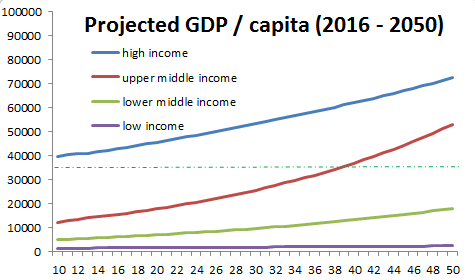
The dashed green line illustrates the ‘decoupling’ threshold, i.e. the point beyond which getting richer no longer causes more per capita emissions. As you can see, while the ‘Upper Middle Income’ countries pass this threshold, the ‘Lower Middle Income’ countries – and remember in population terms these are the big guys – won’t even have got there.
Using our equations which we estimated above, let’s now link this assumed GDP/capita path to what we know about birth rates and death rates and see what that gives us for total population:
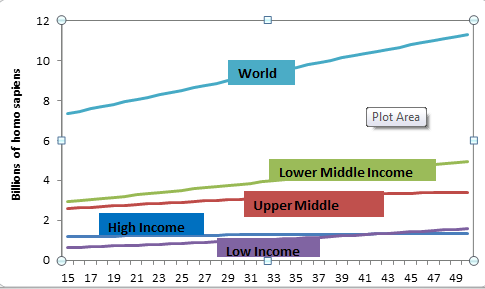
Now, there’s an awful lot to say about these “GDP driven” estimates of total population on earth. The first thing is that it gives us an estimate of 11.4 billion for the 2050 population, which is a good 1.7 billion more than the UN’s estimates. When you compare the two sets of projections line by line, you see that the differences are in the two “Middle Income” categories. The UN’s estimates seem to assume that these countries population’s will grow more slowly, driven by a faster decrease in birth rates.
The next major difference is that unlike the UN’s demographic projections, these GDP driven projections show no sign of population levelling off any time soon. Indeed, it seems to imply that for the bulk of countries, there’s a good ways to go until death rates overtake birth rates. (I’m willing to put my hands up and say I’m not a demographer, so maybe there’s things I have missed. For one thing, my modelling takes no account of migration trends. I guess I’m kind of assuming that for the world as a whole, net migration is zero. But as people move from poor to rich countries, their birth rates also change, so it’s possible to argue with my numbers).
Now you might be tempted to say: hang on, you just assumed GDP would grow like that. What if growth levels off? Wouldn’t that solve the problem?
Not really. If we change the model so that there is zero growth in per capita GDP from now until 2050 for all four classes of countries, here’s what we get:
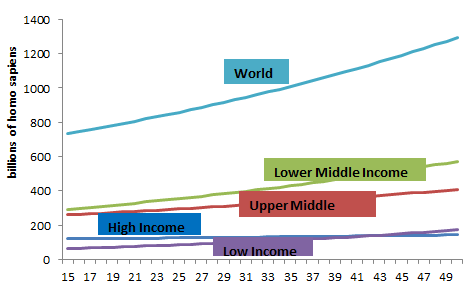
Now the 2050 population is projected at a whopping 13 billion! This is because the lower per capita GDP among the ‘middle income’ countries is driving higher crude birth rates.
Finally, let’s bring this all back to total GHG emissions. If we plug these population numbers into our estimate for per capita GHG emissions by income level, we should be in a good position to tally up the total GHG emissions that this implies, under the two scenarios (no growth and growth at the average).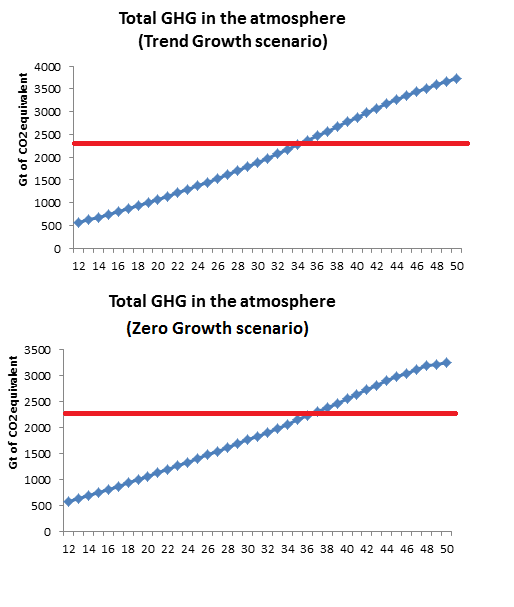
As you can see, with zero economic growth, the level of emissions is lower, but still really high. (The reason why it stays so high is because, at zero growth, although lower middle income countries like India are not pumping more GHG into the atmosphere, the rich and upper middle income countries still are. Furthermore, while the per capita emissions of the poor stays low, their numbers are increasing at a faster rate.)
For both graphs, the red line indicates the UN’s uppermost threshold (2,310 Gt CO2) for their most extreme emissions scenario. Therefore, the current projections put us on a path of GHG emissions that would mean temperature increases to 2100 of more than 4 degrees Celsius. Once again, well off the charts!
Can technology save our bacon?
It’s entirely possible that sometime next year, “they” will discover cold fusion, a carbon-less, virtually free and infinitely renewable energy source that will allow us to rapidly decarbonise and merrily turn the planet into some kind of Coruscant. I have no clue whether this is a realistic prospect.
But sadly, neither do the people who seem to be depending on it as a solution. And my instincts tell me it is very bad policy to rely on a solution not yet invented in order to solve a problem so grave that it threatens our species’ very existence.
Maybe the way to save our bacon is simply to stop eating it? Lowering our consumption of meat and other carbon intensive goods will surely help. Yet when we look at the scale of the challenge as outlined above, it is clear to me this can only be a part of the solution.
Given that the underlying problem is that there are a lot of people in the world, birth rates are higher than death rates, and most of the world’s poor are getting richer, it seems to me that – absent Cold Fusion – there are really only two other choices:
1) Keep the poor as they are: poor. Stop them from developing economically, so they can’t burn the CO2 which we, the rich folks, have been torching for decades now. Don’t let them have decent houses, clean water or high protein diets, because these things cost carbon, and we haven’t got it to spare. This solution would likely work but it seems to me to be highly immoral. I would hate to live in squalor, be hungry, or to not have healthcare. So I don’t want to espouse policies that depend on others having to live in a way I would not.
2) Move to a Global Single-child policy: The one-woman, one-child policy is the best way there is of controlling these effects. Policies which shift the birth rate equation down at all income levels are the ones most likely to achieve our environmental aims without having to inflict misery and suffering on our own species, or on others. It would take a policy step-shift in thinking to address these problems, but as far as I am concerned, when I look at the numbers, I am certain that this is the only reasonable policy solution there is. We can start by asking religious leaders like Pope Francis to change their messaging around birth control.
And, of course, we can stop thinking of demographic change in the West as a ‘problem’. It isn’t a problem, it’s the start of the only real solution.
NOTE: I am including the full set of data which I used to do all calculations. I welcome any corrections or suggestions for improving the model.
Dirty old classism
As I prepare to leave Dublin, I find myself reflecting on the things that make life in this city special. Many are splendid: the quick Dublin wit, the pleasant gift of the gab, the unique blend of international culture and local identity. But some are less worthy of celebration, and in this category I would place social class. I have travelled much in my life, and made it my business to understand a place as well as I could, but nowhere have I observed a social class structure quite like Dublin’s. For an issue that barely gets mentioned, class is everywhere on the streets of the Fair City. The fault lines are so visible that you can determine a Dubliner’s social class by their dress style, by their manner of walking, by the very first syllable of the first word that comes out of their mouths; even by the complexion of their skin. Not to mention the neighbourhood they live in: Even the city’s postcodes are euphemisms for the class of its residents.
By way of example: If you’re 25 and you grew up in Clontarf or Clonskeagh (postcodes 3 and 14, respectively), you went to college – probably either UCD or Trinity. If you grew up in Clonsilla or Clondalkin (15 and 22), you did not. The former ‘Clons’ are non-smokers, they support Leinster rugby, go on holidays to the South of France, shop in Dundrum or Powerscourt and work as accountants or barristers; while the latter Clons smoke, support Celtic or Manchester United soccer teams, go on holidays to Spain, shop in Blanchardstown or Liffey Valley and work as builders, shop assistants or else simply draw the dole.
Inequality of opportunity
That wouldn’t be so bad, if it were simply a case of hard work and merit allowing those who earned it to rise a little higher than others. But the truth is, your postcode has little to do with hard work and merit, and much more to do with who your parents were. You need only look at a Dublin child of 10 for a few short seconds and you will be able to project the course of their future prosperity, to a shocking degree. The ones with poor skin, screaming at the top of their lungs in public, and with their feet up on the opposing seat of the Luas Red Line train which they ride late at night without either a ticket or parental supervision, will not command decent salaries in 20 years’ time. The truth is, they have zero chance of advancing up the social hierarchy. Conversely the 10 year olds you meet in the Luas Green Line train, en route from their fee-paying private school in Milltown to their violin lessons in Ranelagh are almost certain to succeed, economically and socially. No matter how lazy they are in school or how badly the bow screeches across the strings, come 2036 they will probably be doing just fine.
Of course, I am deliberately picking extreme cases, in order to make my point. In reality there is a spectrum of privilege and disadvantage. Class is a fluid concept. But the observation is more than just anecdotal. A recent study shows that Ireland stands out among its European peers as having the highest intergenerational persistence of low educational attainment and the highest wage penalty for having a father with low educational attainment. In other words: if your dad didn’t finish secondary school, you won’t either. And you probably won’t earn very much money. This is a bit true everywhere, but it’s especially true in Ireland, and – though I haven’t got data – I’d be willing to bet it’s even more true in Dublin.
Does social class really matter?
I’ve sometimes been accused by those who know me well of over-focusing on this issue. After all, can’t we just let class be class? Some people read The Sun, others read The Guardian. Some people spend their leisure time in betting shops, others in art galleries. If that’s what makes people happy, why is it a big deal?
Unfortunately, class is more than just a preference in culture and clothing. It determines the quality and length of life, not only for yourself, but for your children and their children. The OECD indicator below shows this Class Mortality Gap in brutally stark terms:
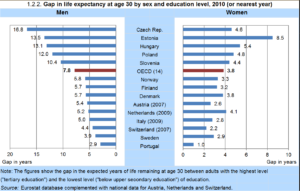
While there is a wide variation across countries, what the chart reveals is that being middle class (i.e. you went to college) adds about 4 – 8 years to your life, depending on whether you are a man or a woman. This makes the Class Mortality Gap almost as bad as the Gender Mortality Gap. Having the misfortune to be born to socially disadvantaged parents is almost as bad for your health as being born with a penis.
De bleedin’ elephant in de roo-um
What makes the social class phenomenon in Dublin all the more eerie is the absence of meaningful discussion of it as an issue. The liberal commentariat are hardly silent on women’s rights, traveller’s rights, abortion rights, gay rights and just about any other social issue you can think of. Rightly so, you may well say. But on social class, their silence is deafening. It’s the last taboo subject in polite Irish politics. Worse: There’s a myth of classlessness in Irish society that seems to be perpetuated whenever you bring the subject up. Class, so the narrative often goes, is something that happens in England. And even then, the Irish of rank and privilege are most comfortable with it when it appears in BBC period dramas. Best to keep the Irish Sea and a hundred years of history between ourselves and the whole messy business!

Myself and my equally middle class partner recently went to see a show at a pop-up theatre in one of Dublin’s more middle class gated parks: Merrion Square. In the queue for pre-show food (wraps, don’t you know – one had one’s choice between halloumi and falafel) we conversed politely with our fellow show-goers, using rounded vowels and fully enunciated consonants. Then it was time to filter in to our seats. The show was called “Riot”, an eclectic mix of acrobatics, music and political commentary, featuring Ireland’s most famous drag queen, Panti, who since the Marriage Equality Referendum last year has become something of a national treasure. The politics played very much to the crowd. In between slapstick gymnastic routines and sing-songs, there were frequent called to “Abolish the 8th”, a reference to Ireland’s constitutional prohibition on abortion-on-demand.
But the showstopper was a young artist named Emmet Kirwan. He hails from a working class Dublin area known as Tallaght – a suburb built in the 1970s and 1980s to cope with the overflow from crowded inner city neighbourhoods. Kirwan’s unique blend of the Dublin working class vernacular and hip hop was as electrifying as anything I had seen on stage. With such an overtly political tone to the production, his indisputable talent and the obvious power of the medium to convey just such a message, this was surely the perfect opportunity for Kirwan to cast some home truths into the sea of class privilege upon which he gazed. I was waiting for the lyric: “A boy of three / undernourished and weak / Can’t afford to eat / Cause his ma’ don’t take home in a week / what youz are after spendin’ to sit in dah’ fuckin’ seat”
That lyric never came. Kirwan was happy to bang on about poverty, but he kept the teeth of social disadvantage well away from the manicured hands that were feeding him. The audience took it all in politely, letting out a dutiful cheer whenever the politics of the left-leaning middle class were voiced (pro-choice, anti-Catholic church) But nowhere was there an honest recognition of the dissonance between the culture on the stage which they were happy to expropriate, and the social reality of that culture’s roots, which they and their parents not only avoided at all costs, but in fact were the ultimate authors of.
Choose your parents carefully
If class is so present, such a problem, and yet Dubliners are so unwilling to talk about it, can anything be done? Is there anything more concrete we can offer to young people who’ve already made the mistake of not selecting rich parents before they were born? Or is it just too late? I, for one, think there’s quite a lot that could be done. We could start by looking at how (and in which neighbourhoods) social housing quotas are being filled; taking a hard and honest look at how the State is subsidising fee-paying private schools; looking at thresholds for inheritance and gift tax.
But before we get to concrete policies, the discussion has to start by acknowledging de bleedin’ elephant in de roo-um. Here’s my lyrical contribution:
Dublin is a class-riven city,
And the cost of that is shitty.
We bury are heads in de sand
Makin’ like it was all grand.
Wha’ a bleedin’ pity!

Despite my better judgement, I have recently found myself getting into social media exchanges with supporters of Hillary Clinton’s presidential bid. These exchanges are often acrimonious and always pointless, because no one ever manages to convince anyone else of their point of view on social media. However, the arguments propounded provide some interesting insights into where this campaign has taken us.
When I express my preference for a third party candidate, Hillary supporters usually begin – not by extolling their candidate’s merits (even they realise this is a claim too far) – but by using the now familiar argument that a vote for Jill Stein or Gary Johnson is a de facto vote for Donald Trump. This argument is of course nothing new. Years ago it was derided in a Simpsons episode in which Bob Dole and Bill Clinton are revealed by Homer to be nothing more than the hideous space aliens Kang and Kodos, bent on enslaving humanity. When a member of the crowd then threatens to vote for a third party candidate, the aliens mock him. “Go ahead, throw your vote away.”
Back to the Social Media exchanges: I usually respond to the Kang and Kodos argument by explaining that although I think Trump is a thoroughly repugnant individual and an awful candidate, at least he won his party’s nomination through a fair and open process, and he did so against the wishes of the party elites. The same, I point out, cannot be said for Clinton; certainly not after the latest Wikileaks revelations. I then note that I believe the price America would pay (i.e. a Trump presidency) in order to punish the DNC for rigging the nomination would possibly be worth it, if the sting to the DNC was so great that it delivered real electoral reform for the next primary process. After all, what is at stake is something greater than 4 years of stupidity. It is the essence of democracy in the United States.
What follows from Hillary supporters is a strange defence of the democratic nomination process being rigged. They often say something like, “Well, the process isn’t intended to be fair.” or “Parties can do what they like. They don’t even have to involve the electorate if they don’t want.” or else even “There’s nothing in the Constitution about how the DNC must organise its nomination process.”
This is of course perfectly true. Except when you combine the two arguments, “the DNC can rig all it likes and choose whomever it pleases” + “a vote which is not for the DNC’s chosen elitist is a vote for the other monster on the podium!” you essentially have an admission that the choice of president is in no way democratic. If the party nomination processes offer no real choice, then the two-party general election certainly doesn’t either.
So if the Constitution does not provide guidance on the fair administration of primary contests, perhaps it is time for Constitutional reform. After all, the current system is so badly broken that even the most ardent supporters of the candidate whom bookies say is going to win in November (let’s call her “Kodos”) can only invoke the Kang and Kodos defence to convince us to vote for her.
In the meantime, I will be using my vote in November to punish Debbie Wasserman Schulz and the DNC for what they have done to Bernie Sanders’ Political Revolution. I will be voting for Jill Stein, and I’ll be encouraging red state voters to choose Gary Johnson.